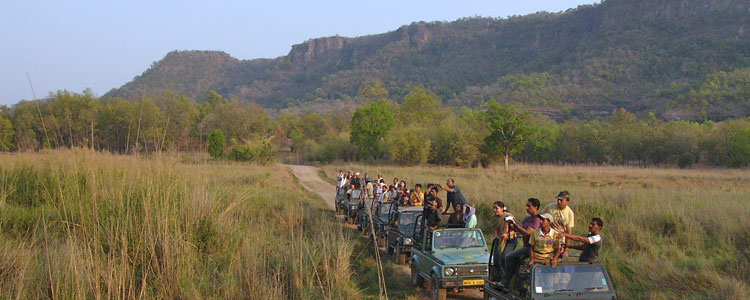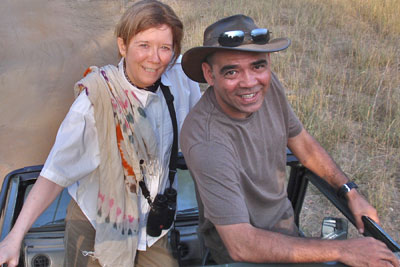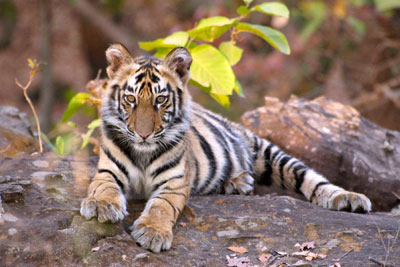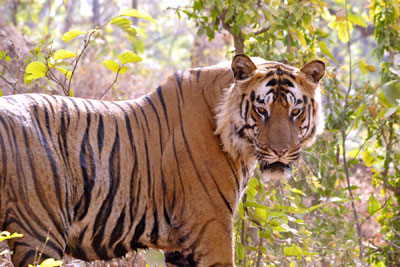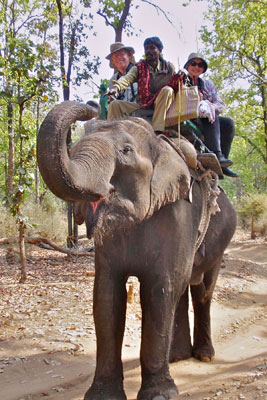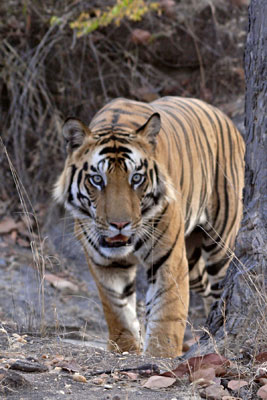Tracking the Royal Bengal tiger in India’s Bandhavgarh National Park
by Bill Bechtell; Montara, CA
My journey to India began when my wife, Peggy, an ardent wildlife photographer, read an article in the May ’09 issue of Outdoor Photographer magazine. The article, called “The Quest for Tigers” and written by Susi Allison-Lama and Butch Lama, described where to find and photograph the elusive Royal Bengal tiger. Featured was Bandhavgarh National Park in central India.
We had been to Africa twice to photograph the large mammals there, to Alaska several times to photograph grizzly and brown bears and to northern Canada for polar bears. One of the few remaining large mammals for Peggy to photograph was the Bengal tiger, and what better time to go than 2010, the year of the tiger?!
Getting there
Peggy contacted Susi and Butch, who, as luck would have it, co-owned a travel company called Wild India (Saint Louis, MO; 314/721-5351, www.butchlama.com), specializing in India’s wildlife and wild places.
Butch is the head guide, with over 20 years’ experience tracking and photographing tigers, and Susi is the chief organizer, handling everything else. They arrange guided tours for groups of two to eight people, not only to Bandhavgar but to other national parks and destinations in India.
Our trip began in New Delhi. After a long flight from San Francisco, we were met at the airport by Anees Ahmed, who did a wonderful job of escorting us through the chaos of Delhi to the nearby Radisson Hotel (www.radisson.com/newdelhiin), where our overnight accommodations were excellent.
Anees drove us back to the airport early the following morning for the hour-and-forty-minute flight on Kingfisher Airlines to Jabalpur, where we were met by Butch and a driver for the four-hour drive to Bandhavgarh National Park.
We checked into Bandhav Vilas lodge (www.bandhavvilas.com), about two miles from the park entrance. The lodge was very comfortable, with air-conditioned rooms, a pool and a restaurant.
Daily activities
Typically, our day consisted of two game drives in the park, one in the early morning and the other in the late afternoon. Each drive was three to four hours in duration.
On four of the days, our game drives were with Butch and Susi in their “jeep.” (The “jeeps” that are ubiquitous in the park are not really jeeps but tough little four-wheel-drive, open-top vehicles manufactured in India by Maruti Suzuki.) The other three days, our game drives were on elephantback.
Each mode of transportation had its advantages and disadvantages. Park regulations require that vehicles stay on the roads, whereas elephants can go off-road to track and follow tigers. The jeeps, however, are able to go farther faster than the elephants.
I think the opportunities for seeing tigers are greater in a jeep than on an elephant, but I recommend booking at least one day on an elephant just for the experience.
With either form of transportation, it was necessary to protect ourselves from clouds of dust.
Maybe we were just lucky, but we saw tigers on almost every game drive and had many wonderful photographic opportunities. We saw a total of eight tigers: two males, two females and two sets of cubs.
In addition, we spotted a sloth bear and a leopard. I think our good fortune in spotting wildlife was due in no small part to Butch’s skill.
Tracking tigers
The park entrance gate opened at 6 a.m., although we had to be there half an hour early to satisfy the Indian penchant for paperwork. We tried to be first in line, because then it was easier for Butch to “read” the pugmarks (tracks) of the tigers, who like to walk along the dirt roads at night.
Butch would drive along slowly, reading the tracks, and could tell which tigers had walked along the road, about when they were there and where they probably were headed. Although radios were not allowed in the park, whenever one jeep would pass another the guides would share information, and through this process the probable locations of the tigers was narrowed down.
When we suspected there was a tiger in the vicinity, we would stop, turn off the engine and listen for alarm calls from the spotted deer and Hanuman langurs (monkeys). These calls would confirm that a tiger was in the area, and Butch’s sharp eyes would usually spot it within a few minutes. He would then position the jeep so that we would have a good camera angle.
In spite of conservation efforts, tiger populations are steadily declining, and the future existence of tigers in the wild is far from assured. Ironically, what is now Bandhavgarh National Park was once the private hunting grounds for the maharajas of Rewa, where hundreds of tigers were killed.
By official count, there are only about 1,400 tigers remaining in India, and last year 60 deaths were reported. Thirteen tigers were killed by poachers in just the first three months of 2010, we were told! Pressure on the tigers is coming from many directions: mining and construction interests, conflicts with villagers, and poachers who sell the skins and other body parts for use in traditional Chinese medicine.
Bandhavgarh National Park probably has the densest Bengal tiger population in India, with approximately 50 tigers roaming an area of about 170 square miles, and is one of the best places to still see tigers in the wild.
Other attractions
Tigers are not the only attraction at this park. The landscape is dominated by a 2,600-foot-high mesa on which is located the ruins of a 2,000-year-old fort, a Hindu temple and beautiful Hindu statues and stone carvings.
One afternoon we drove up to the top of this mesa on a very steep, rocky road. We gave a lift to a Hindu priest who still occupies the temple at the top and conducts two pujas (religious ceremonies) a day.
Exploring the ruins at sunset and looking down upon the sal forests and meadows far below was a very memorable experience.
On one of the other days, between game drives we took a guided tour through the nearby tribal village of Kuchwahi. We had an excellent guide, Ran Veer Singh, who introduced us to several families who were very friendly and were pleased to show us their homes.
The villagers, who have no electricity and only one community well, subsist mainly by farming and occasionally doing work related to the tourist industry. Of course, the children were fascinated with our digital cameras.
It happened that our 30th wedding anniversary fell on a day when we were at Bandhav Vilas lodge. The resort executive Vijay Kumar Parwar surprised us with a wonderful cake. You do not see many cakes or pastries in India, so this took a special effort on the part of the lodge staff.
Vijay was also very accommodating when it came to adjusting mealtimes to our schedule and providing box lunches.
I treated Peggy to an Ayurvedic massage at the lodge’s spa to honor the occasion.
For our final evening at the lodge, Butch arranged a wonderful show of tribal dancing and drumming. We said our farewells to Butch and Susi and the next morning returned to Delhi, where we were met again by our trusty guide Anees and spent another night at the Radisson.
Although tigers were the main focus of our trip, we could not travel to India without visiting the Taj Mahal in Agra. Agra is only a four-hour drive from Delhi, but don’t even think about driving yourself in India!
A driver took us to Agra, where we checked into the luxurious Oberoi Amarvilas hotel, overlooking the Taj Majal. The following day we were met by our local guide, Kamal Kant, who did a wonderful job showing us around the Taj, the Agra Fort and the “Baby Taj” (the tomb of Itmad-ud-Daula).
The details
We took this trip during the last 10 days of March 2010. At that time of year it is fall in India and most of the leaves are off the trees, making it easier to see the tigers. In addition, it is beginning to get warm, so you can often see tigers around creeks and water holes.
This time period, theoretically, is just before the extremely hot summer months that precede the monsoons, when everything shuts down, but we, unfortunately, encountered a heat wave. Afternoon temperatures were over 100 degrees, so we retreated to our air-conditioned room in the afternoons and rested up for the next game drive. Evenings were pleasantly cool.
The total cost for the 10-day trip was $12,325, which included all hotels, transportation, transfers, domestic airfare and guides. It did not include tips or international airfare.
Susi went far beyond the call of duty to coordinate this trip with our follow-up trip to Bhutan. I highly recommend Wild India if you decide a trip of this type is for you.

